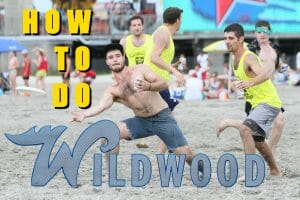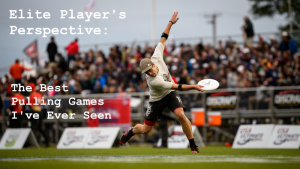
This is the sport. This is the time. This is ultimate.
With this tag line — and a series of slick promotional videos — Major League Ultimate (MLU) burst onto the scene in November 2012 with a clear message: this league is for real and serious ultimate fans should follow it.
It was everything that the American Ultimate Disc League wasn’t. Every piece of news released about the MLU that first offseason separated it. There was the brand. The MLU was a better sounding name for an ultimate league, it produced high quality videos, and had a modern looking website. The league had eight franchises, all located on the coasts with well established elite club teams to draw talent from. And draw talent the league did, with many of the best players in the country signing up to play.
Everything about the MLU exuded professionalism. And expectations.
The MLU was built on the idea that ultimate was the next big sport. This was not a league designed to exist and move along as a niche sport that drew 500-1,000 fans a game. This was supposed to become something bigger. Especially in its early days, the MLU was not shy about discussing its expected growth.
Yet the league didn’t meet those outsized expectations. After perennially failing to reach its goals, the MLU closed up shop for good in December 2016. When the announcement broke, few outside the MLU found it surprising. But there was a time when it seemed like not only would the MLU outlive the AUDL, it could become something much bigger.
Shortly after the MLU was announced in October 2012 the league got moving. Teams were announced. Staff was hired. Players and coaches signed on. So much happened so quickly, in fact, that the league ended up putting too much on its plate. Initially, the MLU was slated to be a ten team league, with markets in New Jersey and San Jose along with the original eight announced. A Midwest division was put on the schedule, slated to come into being in 2014, with teams in Minneapolis, Toronto, Chicago, Pittsburgh, and Denver. Those teams never came to be.
“We were thinking about the wrong things at the wrong time,” according to Jeff Snader, who was Commissioner of the MLU from 2013-2015. “From a sports perspective we wanted to expand and add more teams, even though financially and logistically, it was a silly idea.”
Those ten teams were supposed to operate on a $1.25 million budget. The MLU ended up with eight teams and a budget just over $600,000 in that first year. The concept of the league was only created in September 2012, and the league opened the following April. It was quite the turnaround. Snader thought it could have waited another year. “I wish we would have said ‘It’s going to take a whole lot more money’ and waited until we raised that money,” he said.
“We were thinking about the wrong things at the wrong time.”Jeff Snader
Waiting another year to open the league would have probably meant a bigger budget, a smoother season, and better preparation, but the drawbacks might have been even more significant. The idea of waiting a season when the AUDL was starting to right its ship could have accelerated that league’s growth.
When the MLU opened in 2013, it had a near monopoly on the elite men’s talent in every city it was going head-to-head against the AUDL. Delaying the start time might have meant that elite talent came into the semi-pro ultimate scene with the AUDL rather than the MLU, in a year that was not nearly as scandal fraught as the inaugural 2012 AUDL season. As it was, many of the best players that played in the AUDL in 2012 shifted to the MLU in 2013.
One of those players was Brandon Malecek, who played for the Rhode Island Rampage in the AUDL before joining the MLU with the Boston Whitecaps in 2013. To him, the contrast between the leagues was clear from the start.
“The Whitecaps had all their ducks in a row,” he said. “They knew exactly how they were going to do tryouts. They had all the logistics sorted out prior.”
Despite the quick turnaround, the early returns for the MLU looked good. The teams were great, they played close games, much of the ultimate community embraced the league, and the crowds weren’t bad either. In their inaugural 2013 season, the league averaged 700 fans per game.
“It was quite a hectic time. That first season was a sheer force of will of Jeff’s. It wouldn’t have happened without him,” according to Mark Evangelisto, who served as the general manager for the Philadelphia Spinners in 2013 before taking on numerous other roles in later years.
“It was awesome to play in a stadium ten times a year in front of a lot of people,” said Morgan Hibbert, who played in the MLU with the Vancouver Nighthawks from 2013-2015. “It was great to interact with the younger fans. No one is going to come watch Furious George play in Vancouver because we never play here. It got the kids way more engaged in the community.”

In many ways, the first year was the best season the MLU had. Excitement for the league was at a high point that it never quite equaled again. Attendance was higher than it would be in later years. And the idea of comparing the AUDL to the MLU seemed like a joke. Outside of their franchises in Toronto and Madison, no team in the AUDL came close to matching their MLU counterparts.
Of course, it wasn’t just the talent on the field that separated the MLU from the AUDL. It was the presentation of the product across all eight markets that gave it the kind of professional feel that the AUDL lacked. At a time when the AUDL generated next to no content of its own, the MLU was miles ahead.
“The MLU did a great job of pushing out content, creating great articles to get people excited about the league,” said Malecek.
And with the centralized control of the league, producing that content was much easier. So was making sure that there weren’t markets lagging behind, as they were in the AUDL.
“We learned a lot about how to put on a game and make it consistent across cities in that first year. You got the same kind of experience in Boston as you would in Philadelphia or San Francisco,” said Evangelisto.
Oh, and the league live streamed two games per week for free on YouTube. What wasn’t to like?
“Streaming was one of the worst decisions we made. It literally gave away our product for free because we thought that was cool and necessary,” said Snader. “We should have focused on the fans who were buying tickets. Looking back, that was a real mistake.”
On this subject, there is little agreement among those that worked in the MLU. Greg Fallon, who worked for the MLU from 2012-2016 ending up as a post production coordinator, disagreed with Snader’s assessment. “I think the live streams were very important,” he said. “The attraction of live sports vs. tape delayed sports is very dramatic. I think it was wise to put our resources into that.”
This difference in many ways epitomizes the MLU. The decision to stream games — and to do so for free — undoubtedly generated a great deal of interest in the league. It resulted in more people following the MLU, more people visiting the website, a decent number of people tuning in and watching games, and a chance to win the favor of the ultimate community at large. Streaming contributed to the feeling that the MLU was “winning” the semi-pro competition game against the AUDL, whatever that meant. Little, if any of that, is disputable. But did it really matter?
“You would not believe the horror stories that would go on in trying to get these streams up and running. It was a battle.”Mark Evangelisto
To Snader, in hindsight, there wasn’t much question that it didn’t. “It was for the ultimate community and it was for a bunch of people that didn’t want to pay anything,” he said. “That is not the group we should have been focusing on. We got sponsorships with it, but we could have gotten sponsorships without it.”
As with every failed business venture it’s easy to look back and second guess the allocation of resources. But this was a significant resource. Streaming took time. Streaming took money. Both were resources the MLU had much more of than the AUDL in 2013, but that didn’t make it any less important a decision. “We did a great job of covering the games and getting the streams out,” said Evangelisto. “And you would not believe the horror stories that would go on in trying to get these streams up and running. It was a battle.”
It’s hard to imagine how the MLU would have been received without streaming their games for free. It was something the league did without precedent, helping set the standard for free, on-demand ultimate online. And the hope was that it would showcase the league in such a way that it might make it attractive to potential broadcast partners. The live streams generated fans across the country, even outside the eight markets the league was in. But what did those fans that wouldn’t be going to games bring the league?
The MLU streamed games because it was envisioned as an “act as if” league. The league front office made the conscious decision to act as if it was just as big and important as the most popular professional leagues in the country, which they believed would translate to increased popularity in the long run. That mentality was part of what drove the MLU’s popularity in its early years, and streaming games for free was a big part of that.

“It was important for us to livestream our games for free,” said Fallon. “It pushed a lot of other people in ultimate media to stream their games for free. It increased the exposure and the viability of watching ultimate online.”
On that point, he is undoubtedly correct. In 2012 and 2013, the AUDL offered live streams, but at a cost. In 2014 they started offering free weekly live streams, and pointed to the MLU as a reason for it.
It’s impossible to quantify what kind of benefit streaming brought the MLU, but the question does go to show that just because the MLU could do something, didn’t necessarily mean that it should do it. It’s an issue that would come up with the league time and again over its four years in existence.
At the end of the 2013 season, the league was still just getting its feet off the ground. They had nowhere near the level of sponsorship support they would in later years. The league office was still getting defined as many people switched roles heading into 2014. The league was still outsourcing much of its work, including its livestreams, on the west coast. Given how quickly the MLU needed to turn around and get games started, there wasn’t the kind of solid strategic plan that some would have liked. Despite all that, the league appeared to have experienced a very successful inaugural season.
“In 2013, one league was jerking around and the other had all its shit together,” according to Malecek. “I really thought the MLU was headed in the right direction.”
Signs Of Trouble?
IN AUGUST OF 2013, Bryan Ricci*1 stepped down as CFO of the MLU and told Ultiworld, “I think the league missed its revenue targets. They were somewhat aggressive being the first season.”
In what is regarded as either its most or second most successful season, the MLU didn’t do as well as it thought it would. That speaks to the kind of expectations the league had for itself. Those expectations would become even clearer later on in the offseason.
When Jeff Snader gave an interview on the MLU that offseason, it was a different time. The MLU was coming off a big year and the AUDL seemed like the little kid trying to sit down at the grownups table. So when Snader talked about the kind of growth the league expected, it was notable, but didn’t seem anywhere near as outlandish as it does in hindsight.
“Our big goal is in 2018 that we want to have a steady 5,000-person fan base for each team. That’s really our growth or break even point,” Snader told Ultiworld in December 2013. “I’m targeting 950 average paid attendance in 2014….in 2017 or 2018 I’d like to see the average player making $4,800 a year playing for us.”
Now, especially when he was Commissioner of the MLU, Snader was always known to speak in grand terms. He had a vision for professional ultimate, and worked as hard as anyone to realize it. Even given that though, those kinds of expectations were plainly unrealistic. Snader and Nic Darling*2 hosted a podcast in which they were never shy about criticizing the AUDL business model for its rapid expansion growth. But the MLU was clearly dealing with issues of its own expected growth, albeit of a different kind.
“It always comes back to money. Sooner or later you have to turn a dime,” Snader now says. “We oversold what we were going to do and how quickly we were going to do it and got behind the eight ball with the investors.”
There is no consensus on how concrete those expectations were. “In retrospect the projections were way off,” said Evangelisto, who was also a minority investor in the league. “But I don’t think any investors that came in had any notions that this was going to be a quick turnaround. It’s certainly a lot longer haul than two or three years.”
“At first I was confused to why it [elite players leaving] was happening. It was clear to me that the MLU was a better product.”Brandon 'Muffin' Malecek
Outsized expectations or not, that was nowhere near the biggest news of the first MLU offseason. In November 2013, Beau Kittredge decided to leave the San Francisco Dogfish to join the San Jose Spiders of the AUDL. The Spiders were one of the six expansion franchises the AUDL opened in 2014, and most of the talent from Revolver left for the AUDL with him. “There was no give and take in the MLU,” Kittredge said at the time. “You are just owned as a player and everything is predetermined.”
“At first I was confused to why it [elite players leaving] was happening. It was clear to me that the MLU was a better product,” said Malecek. “When you want your team to have their own identity and their own spin on it, as opposed to everything being the corporate, professional brand, I can see why they might have done that.”
“I never heard stories where you couldn’t go to the coach or owner and say something,” said Delrico Johnson, who played with the DC Current from 2013-2016. “I think the conversations between players and upper league management went pretty smoothly.”
That offseason, Kittredge and Revolver’s departure was much more the exception than the rule. Most MLU teams upgraded even more for 2014. The excitement level was just as high, even though most presumed the Boston Whitecaps would cruise to another title. A few weeks before the season began though, Snader and Darling made waves on their podcast, calling out USA Ultimate for doing a “horrific job” in serving its membership.
After the initial blowback to the comments, Snader walked some of it back, clarified other comments, and put forth a compromise proposal to USAU just a couple weeks later, with USAU not having responded in the interim. It was bizarre and seemed like the MLU, for all that it did so well, didn’t realize that even in its own players minds the importance of the MLU did not compare to club.
“It was bad strategy because it didn’t help us get fans in the stands,” Snader says. “It was just PR. We made waves. We knew how to ruffle feathers. We knew how to get people to listen and to talk about us. We knew how to drive people to websites and watch videos.”
“I agreed with them, but it was misguided energy,” said Hibbert. “The players still love club. If I had to pick one I’d still pick club. It’s not a good strategy to bash what people love.”
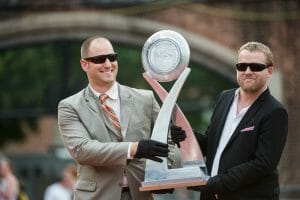
Throughout the entire 2014 season it was a topic that Snader and Darling would revisit, relentlessly pushing the MLU as an entity that USAU should partner with to grow the sport. After the initial opening salvo the language was softer and the tone more diplomatic, but the message was the same: USAU wasn’t treating its elite players right with the Triple Crown Tour, and ignoring the MLU was a missed opportunity that could have increased USAU membership. It did get people’s attention.
In some ways the decision to go after USAU had a lasting effect on the perception of Snader in the MLU and even more so the ultimate community. To many it permanently painted him as an overly critical, negative leader of the league. He was still popular among some and led the league to a fairly successful 2014 season, but having the most public face of the league be perceived that negatively did it no favors in the long run.
“Mission accomplished for what we were trying to do, but it was the wrong mission,” said Snader. “The mission should have been getting more fans in the seats.”
While the MLU didn’t get quite as many fans in the seats in year two as it did in year one, there were other ways in which the league seriously improved. The most important of those was probably attracting sponsorships. “Sponsorships were hundreds of thousands of dollars in revenue,” said Snader. “They were a big deal.”
Whether it was brands associated with ultimate like Innova, Elemental, and Spikeball, or those from outside the sport like Skippy, US Coachways, and FanDuel, the MLU always seemed like it was announcing another major sponsorship deal.
“The consistent branding allowed us to approach potential sponsors with a lot of confidence,” said Fallon. “What they saw when we presented was what they would get because they knew we had control over everything.”
The 2014 season represented significant growth in sponsorship revenue over 2013, and in 2015 it would grow again. Sometimes it was a bigger fish like Innova. Other times it may have just been a local bar that a team would go to after their game. Regardless, it was something that the central office in Philadelphia was expected to close, always with an eye on the bottom line.
Of course it wasn’t just sponsorships that made the 2014 season so successful. While the AUDL had a few teams that could rival (and probably beat) the best teams in the MLU, the MLU had depth and parity. In 2014, in the AUDL it wouldn’t be atypical to see a team like San Jose, Toronto, or Madison win by 15 or more points. That almost never happened in the MLU. Their games were simply more fun to watch.
“What [potential sponsors] saw when we presented was what they would get because they knew we had control over everything.”Greg Fallon
That year, the Boston Whitecaps were coming off an undefeated championship season. With the best players from the San Francisco Dogfish now playing in the AUDL and many of the best players from the Seattle Rainmakers taking the year off from both leagues, the Whitecaps were the easy preseason championship favorite.
But something funny happened. The DC Current, the team that had been easily beaten by the Whitecaps in the playoffs the year before, rolled to a 9-1 regular season record. They won a thrilling game against Boston in DC, and consistently out prepared and outclassed the rest of the division when the game was on the line. “The excitement around that team during the whole season and watching that team do what it did, it just gave me chills,” said Mark Evangelisto, who was the DC Current Vice President of Operations in 2014.
In the playoffs, the Current won another barnburner against Boston, who had just barely squeaked into the postseason. The MLU Championship was once again taking place in Philadelphia, this time at PPL Park, home of the Philadelphia Union, the local MLS team. They were playing the Vancouver Nighthawks.
That year the Nighthawks started slow, and came on strong during the second half of the season. Morgan Hibbert, who won defensive player of the year for the Western Conference, was a big part of their success. Any fan of the MLU is probably familiar with him, because, like a few others, the league promoted him like nothing else. Talking about and promoting ultimate players like superstars was something the league did better than anyone.
“That was 100% intentional. It helped us be able to tell the stories and have marketable players,” said Greg Fallon, who in addition to producing many of the video segments of the players also hosted a weekly podcast on the MLU discussing who was up and who was down. “The guys definitely appreciated it when they got highlighted.”
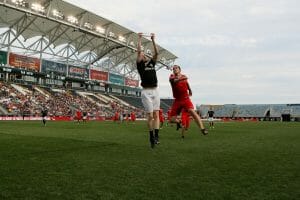
“I grew up watching and playing sports as a child. I had posters on my wall,” said Hibbert. “This pro thing came along and you had somebody else hyping you up and promoting you, it was a good feeling.”
That weekend in Philadelphia, Hibbert and other Nighthawks players were taken out for dinner and drinks, from one PR event to another. The next day in the championship, fans turned out for some high level ultimate, between two teams mostly composed from elite club ultimate teams Truck Stop and Furious George.
“Everything was organized, and every detail was taken care of,” said Hibbert. “I was the last one from my team to leave the field, I remember trying to soak in the moment, you don’t get many opportunities to be in a situation like this. If only we had shown up and made it an exciting match.” The Nighthawks did fall behind, trailing 13-4 at the end of the first half, before losing 22-17. But the lack of suspense didn’t take away the feeling of momentum that many in the MLU had in that moment.
“At the end of 2014 everyone was really pumped. We had a really successful year,” said Fallon. “Everything seemed to be trending in the right direction.”
Mark Evangelisto agreed. “I came away from that season thinking there was a good chance at getting to a point where we’d be sustainable and start growing,” he said.
A Missed Opportunity?
GROWING. IT WAS something the league hadn’t seriously discussed since its first game took place in 2013. It was something the AUDL was not bashful about. But many believe that if the MLU were to expand, the time to do it was after the 2014 season.
“The MLU peaked after the 2014 championship,” said Matt Dewhurst, General Manager of the DC Current from 2014-2016. “It was a huge crowd in a professional soccer stadium with lined grass, and it was just a great production. You left thinking we were on the cusp of something big. We left a lot of opportunity on the table when we didn’t pull the trigger and expand. That’s when we should have done it. If we’d have done it then, I think we’re not having this conversation now.”

Of course there’s a reason the MLU didn’t expand. It couldn’t afford to.
Yes, despite the slight drop in attendance, it’d be fair to characterize the 2014 season as an improvement over 2013. Things went smoother, there was more sponsorship revenue, and the league appeared to have avoided a sophomore slump. But the MLU was already spending a lot of money. Increasing the number of teams and expenses by 25% or 50% just wasn’t feasible for a limited investor group. Yes, the league was doing better with sponsorships, but investor money was still the lion’s share of league revenue.
This also wasn’t a decision being made in a vacuum. There were two semi-professional ultimate leagues. One was bringing in new cities, adding exciting new teams and players. The other was not. For all the talk Snader and Darling had about unsustainable growth in the AUDL, they never mentioned that fans and players are attracted to new things. To bigger things.
“The league was cautious to a fault,” said Evangelisto, who served as director of communications for the MLU in 2015 and 2016. “It wanted to control its growth. It was a reasonable thing to do in the early days, but given the way the landscape evolved, it held us back. There was a reluctance to innovate and adapt with the way the landscape changed with pro ultimate.”
At the time though, the league didn’t concern itself with the idea of expansion too much. After all, it was coming off a second successful season. Most indicators were trending in the right direction. Why overreact to a league that had teams in places like Rochester and Salt Lake City getting blown out on a consistent basis? The MLU had an approach and was sticking to it.
Before the 2015 season, the landscape of the MLU changed significantly. Most of the Vancouver Nighthawks, the team that had just played in the MLU championship on the biggest stage the league had to offer, left to play for the Vancouver Riptide of the AUDL. More players from the New York Rumble, who had a disappointing 2014 season, left to play for AUDL teams. Some of the best players on the Seattle Rainmakers chose to play with the new Seattle AUDL franchise being operated by the Titcomb siblings that co-own Five Ultimate.
“2015 was kind of a rough year,” according to Fallon. “I think it took a lot of people by surprise. We were bleeding talent at that point, especially on the West Coast. We tried to do east and west coast games by ourselves. I don’t think any of us predicted how difficult the travel was going to be for us. That was another example of trying to do things too fast. The travel was rough on us personally.”
The MLU staff was stretched thinner and attention had shifted to the AUDL. Many players still in the league were restless about its direction, and the quality of play wasn’t what it was the two years prior.
“Buy-in was more difficult after the championship season,” said Dewhurst. “We weren’t playing new teams.”
“We left a lot of opportunity on the table when we didn’t pull the trigger and expand. That’s when we should have done it. If we’d have done it then, I think we’re not having this conversation now.”Matt Dewhurst
Viewership was down. Attendance was down. Sponsorship revenue was up, though, and even in 2015 there was one thing the league brought to a higher level: fantasy ultimate.
In 2013 and 2014, the league ran a fantasy ultimate site through Ultiapps, and it was fairly popular. But in 2015, fantasy ultimate took by far its biggest step forward. The league designed its own platform that featured live drafts, head-to-head matchups, easy lineup management, and the ability to add and drop players.
Some elite talent left the MLU before the 2015 season but with players like Morgan Hibbert, Chris Mazur, Jeff Graham, Khalif El-Salaam, and the defending champions in the DC Current, there were still plenty of players to get excited about having on your fantasy team. The product was good. And free.
“Why we built [the fantasy system] was very much a business decision,” Nic Darling explained on an episode of Cleats & Cufflinks in April 2015. “Fantasy provides a platform of highly engaged users that we can present to sponsors and we can marry the two in a way that provides value to both.”
On that same podcast Snader said, “I asked the East Coast GMs to name players on the West Coast. Every GM could name a few superstars. I asked them to name more and they couldn’t. Next year I’ll ask them the same question and they will rattle them off because of fantasy.”
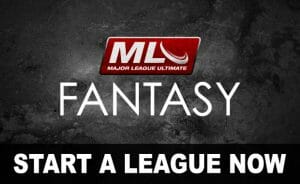
Fantasy ultimate did provide a lot of engagement from a certain set of MLU fans. They spent more time on the website. It resulted in increased traffic. It increased awareness of some lesser known players. It helped mitigate the perception among some ultimate fans that the AUDL was now the league to follow for ultimate fans.
But this move doubled down on the early decision to live stream games for free. It was designed in part to increase viewership of those streams, and was marketed toward the hardcore ultimate fan, a niche within a niche. The MLU produced a lot of content promoting fantasy ultimate. They saw it as a major success.
And maybe it was for what it set out to do. But it hearkens back to Snader’s take on live streams and the PR war with USAU: the MLU accomplished what it set out to do, but was that what it should have been focusing on in the first place?
Unlike the 2014 championship game, the 2015 edition didn’t have the same hype. There was still a crowd and the professional environment was still there, but the excitement wasn’t the same. The Boston Whitecaps were playing the Seattle Rainmakers and the game was never close. The Whitecaps won 31-17.
An Offseason Of Change
JEFF SNADER WAS undoubtedly a personality, one of the biggest in ultimate at the time. But he had begun to wear on a lot of people in the league, and the negative perception around him from his battles with USAU and the AUDL didn’t help. Plus, he’d been running things for three years, four if you count his time running the Spinners in the AUDL in 2012. So in September of 2015, he stepped down from his role as CEO and Commissioner.
“When I started the MLU, I had a vision, and a huge fire in my gut to do it,” Snader says now. “In that last year I didn’t have it anymore. If you’re going to lead you need the fire, and I didn’t. And I think it was apparent. I set goals and said things I wanted to do and we didn’t hit those goals. Someone had to take responsibility for the goals not being hit, and that was me. I was hopeful that could charge up the organization. It just didn’t work out that way.”
“Having Snader as the face of the organization caused a lot of problems, but as a player he made it feel like a family.”Morgan Hibbert
The hope was that without Snader the MLU could shift the dialogue about the league, and create a positive boost heading into the 2016 season. The league realized to do that it would need someone else at the helm. The question is whether someone would really fill the void that Snader left.
“Having Snader as the face of the organization caused a lot of problems, but as a player it made it feel like a family,” said Hibbert. “It was awesome to be a part of. I loved how much Snader cared and his passion. He really cared about his players.”

“Say what you want to about Jeff, but he was very passionate about trying to grow the league and the sport,” Dewhurst said. He was often times not an easy person to work with or for, but he worked hard and he was all in for the MLU. While Nic Darling would essentially succeed Snader as league spokesperson, there was never a new Commissioner named.
“Not filling Jeff’s shoes was the first inkling I had that there were some problems,” Evanglisto said. “Having a figurehead there for the league was very important and I stressed that, but it was never acted on.”
“When I left, I was concerned it wasn’t going to make it,” Snader said, looking back. “We were focused too much on the wrong things. We needed to make more drastic changes and we weren’t there.”
Jeff Snader wasn’t the only person to leave the MLU after the 2015 season. The core of the 2014 DC Current championship left to sign with the DC Breeze of the AUDL. Morgan Hibbert and the Vancouver Nighthawks front office team left to join the Vancouver Riptide. Chris Mazur left the New York Rumble to join the AUDL. Even three year MLU veterans like Jeff Graham and Josh Markette chose not to play semi-pro ultimate at all in 2016. The elite talent that started to move to the AUDL after 2013 had increased after 2014, and, after 2015, more of the biggest stars that MLU had once promoted were playing in the AUDL.
“Bleeding talent was a warning sign,” said Fallon. “But we always thought that if we focused on us, and on creating the best product we could, that talent would eventually come back.”
The question of player talent to the success of the MLU was a complicated question. From a big picture perspective, of course, the league was only going to achieve the kind of success that it set out to if it reached far beyond the ultimate community. The question is whether or not getting the ultimate community behind you is necessary before expanding your base to newcomers.
“I view player talent as completely irrelevant to the success of the league,” Snader still maintains. “I view player buy-in as extremely important.” To a large extent the difference in player talent and buy-in is pretty clear across the course of the MLU. In 2013 and 2014, the league largely had both. In 2015, the league dropped in player talent, but buy-in dropped even more. 2016 was another significant drop in player talent, but the buy-in did increase.
“The elite talent definitely played a factor,” according to Delrico Johnson. “In 2014, the MLU had a good number of big name players. When that switch happened you did see a dip in viewership. But for the fans that showed up, it didn’t matter who was on the field as long as they were watching exciting ultimate.”
And Johnson’s point about it not mattering to the fans that showed up speaks to Snader’s take on player talent. Once the fans show up, what they care about is an exciting game, not how many players each team had appear at Club Nationals. A casual observer won’t know the difference in quality of play. But the fans need to show up first. And the first people to show up to ultimate games outside of immediate friends and family are always going to be ultimate fans.
“For the fans that showed up, it didn’t matter who was on the field as long as they were watching exciting ultimate.”Delrico Johnson
“You need talent,” said Dewhurst. “There’s no way around it. You need names that people recognize, even in a smaller sport like ultimate.”
New fans are more likely to show up and enjoy themselves if it’s an exciting atmosphere, which requires a fan base to begin with, which almost always has to consist of ultimate fans. And competing with another ultimate league in the same city makes getting those fans much tougher if you don’t have the best players.
“I don’t think the talent leaving was the death blow,” said Fallon. “It made our job a little bit harder though. The hardcore ultimate fans wanted to see the best players.”
“The problem that the MLU and the AUDL had at that time was that players felt they had a lot more control, and they did,” said Snader. “They could pit the leagues against each other and get teams to bid for them, and that was tough.”
Having the leagues pitted against each other that way was very difficult on the MLU, because it was a fight that they weren’t really equipped to win. The league structure featured a set stipend per player per game. The AUDL had owners that could take risks that the MLU either couldn’t or wouldn’t, regardless of whether they were the right ones to take.
“Where we were at a disadvantage was our reluctance to take chances,” said Dewhurst. “We didn’t strike while the iron was hot for us. I know a lot of players got frustrated with it. You could see it with the number of players who left after the 2015 season — and even before that.”
Some AUDL teams could afford to respond to the MLU teams in town by outbidding them for their own players. Given that they were independently operated, it wasn’t a decision that had to be made by the league: owners could just choose to go a little bit deeper into their own pockets. The MLU couldn’t do that without significantly increasing expenses league wide.
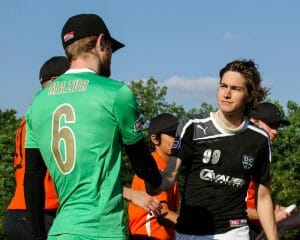
The AUDL could afford to expand because the financial burden fell on each individual team. While that league did — and does — want to expand only into markets that it thinks will benefit the AUDL as a whole, if there are a couple teams along the way that fall by the wayside, they don’t see it as affecting the league as a whole. That was never true with the MLU.
All of this enabled AUDL teams to react to MLU ones in a way that would never be true in the reverse. It’s just not the way the MLU was structured. In a world without the AUDL, the MLU business model made a lot more sense. But that’s not the world the MLU was living in. Of course, not everyone agrees with this assessment.
“The only disadvantage was not focusing the right resources at the right times and ignorance to what we should have been doing,” says Snader. “We just didn’t know. If we had focused on those things and aligned our expectations better, we would have done better. I don’t think we understood how long it was going to take or how hard it was going to be.”
In November of 2015, the MLU announced that it had received another round of investment for 2016 and commitments for 2017 and 2018. It was from Raju and David Kucherlapati’s investment group, which already held the majority ownership of the league. For as well as the league did with sponsorships in 2015, it still wasn’t bringing in significant new investors. And instead of focusing on shoring up the league’s major weaknesses — namely attendance — it decided to double down on its strengths.
“Attendance, particularly for a young and growing niche sport, is a war of attrition,” Darling told Ultiworld at the time. “It’s a long haul. Unless you’re willing to dump tons of money into it, you’re looking at a small percentage growth.”
Instead the league chose to emphasize sponsorship growth, which it was doing well in, but of course ultimately relied on fans watching games.
“Our ability to deliver a lot of eyeballs in person is obviously limited,” Darling said in November 2015. “But digitally our opportunities are much better.” The livestream was even more of a focal point in 2016. By downplaying the importance of attendance, the MLU was relying on the livestream to provide value to sponsors, at a time when interest in the league, especially from those outside the eight markets it was operating in, was at an all-time low.
“Attendance, particularly for a young and growing niche sport, is a war of attrition.”Nic Darling
In fact, not only would the MLU continue their previous one to two free livestreams per week, in 2016, they would offer live streams of every single game. So often in the past, Darling and Snader had chided the AUDL for its rapid expansion, which they said didn’t have a comparable model in professional sports. But practically every minor league has always viewed attendance as the number one factor in determining success. Ticket sales are what drives niche leagues, at least at the start. The MLU was going in the opposite direction.
On the Cleats & Cufflinks podcast in April 2016 with Dusty Rhodes, Darling provided additional rationale for providing every game for free online. There were three components:
- Streaming back to the main office, which makes for better stat keeping, and is good for fantasy.
- Better second screen experience.
- Makes it easier to write about and report on the games.
The surprising thing about this rationale is that it is all geared toward existing MLU fans, rather than growing the paying fan base. Dedicated fans care about stat keeping and fantasy, but casual fans do not. The limited number of fans that want to completely engross themselves in a game might appreciate the better second screen experience, but most won’t. It would make it easier to write about the games, but with the elite talent having left the league, fewer were interested in reading about the league and almost no one outside the MLU was interested in writing about it.
And undertaking this amount of work was no easy task. The games were first sent back to the central office in Philadelphia on encoders, with graphics, game clock, and score being added remotely. “We were doing some crazy stuff with a limited budget,” said Fallon.
In past years, the MLU had drawn headlines, both good and bad. The excitement of the inaugural 2013 season, the 2014 championship, and fantasy ultimate all generated positive headlines for the MLU from 2013-2015. And even if it was negative — the one sided war of words with USAU, suspending a player for criticizing the pulsar, or on the field antics — the MLU was almost always relevant. That wasn’t the case in 2016.
“The passion was still there but it turned into more of a business. It was a palpable change,” according to Evangelisto.
Part of the idea of the change in leadership was that it would allow more focus on the product than the distractions. That part of the plan worked, and though many outside the league weren’t paying attention, those within the MLU look back on the 2016 season fondly.
“In 2016, our games were entertaining,” said Dewhurst. “The product was great. No one can tell me different, I don’t care if the talent isn’t what is used to be or what it was in the other league, just watch the games.”
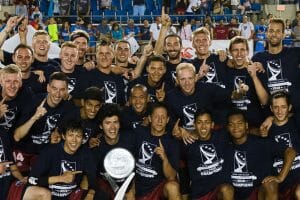
Still, attendance was down from the year before, just as it had decreased every year. The attempt to livestream every game, despite a few hiccups, was successful. But viewership of those games was down too. It wasn’t uncommon to turn on an MLU game in 2016 with under 100 viewers tuned in.
In 2016, the MLU was still doing all the things it normally did. The production value wasn’t any lower than it had been before. The league even focused more on promoting the content it was producing, something they hadn’t done as well the year before. “They did a really good job of showcasing their talent,” said Johnson. “They had these no name players, but they were going to showcase what they can do, and show that you don’t need the big names to make the big plays.”
“For all the talent shift that happened between the MLU and AUDL there was a lot of damn good ultimate going on in the MLU,” said Evangelisto. But from the outside looking in, regardless of how exciting the MLU may have been in 2016, the die had been cast.
“They lost their hype,” said Hibbert. “They lost their momentum. It might have been wiser to try to hold onto the hype of the frisbee community by expanding. They were losing the frisbee community faster than they were gaining other people.”
Despite all that, there was room for optimism. After all, this was just year one of a three-year commitment. And for the first time in MLU history, the Philadelphia Spinners, the hometown team, was headed to the championship.
Despite a weather delay, the MLU championship drew very well in 2016. It set a league record for single game attendance and had some exciting moments. After years of championship games that were essentially over at halftime, Philadelphia and Portland went back and forth, with the Spinners ultimately winning 14-11.
The Last Offseason
“AFTER THE CHAMPIONSHIP game in 2016, we really felt like we were ready to bounce back from all the stuff that was going on in 2015,” said Fallon. “It was the loudest I ever heard any ultimate game. I really felt like we were going to have a good year this year.”
Of course, sometimes those closest to the problem have a hard time fully recognizing it. The MLU had a dedicated staff of about 12 people, varying a little from year to year. These were full-time jobs with benefits. Much of the staff started working for the league fresh out of college. They lived and breathed Major League Ultimate.
The MLU staff did some extraordinary work. Ultimate had never seen the kind of branding, content, and marketing that the league brought to it when it first opened in 2013. But that closeness had its drawbacks too. The league played things very close to the vest, massaged attendance numbers, and was constantly trying to spin any negative about the AUDL or sell its own minor steps as major accomplishments. Maybe it was the business model, going into the office every day and working in the trenches together to pursue an implausible dream, but the MLU produced more true believers than the AUDL did.
On December 21, when it was announced the MLU was folding, all those people lost their jobs in an instant. Vice President of Operations David Kucherlapati wrote in an email to players, “Due to the past losses, future projected losses, and the inherent issues that we have found in our business model, the Board of Directors has decided to suspend operations, effective immediately.”
The reaction from many in the ultimate community was that this was inevitable. Those in the league, though, did not feel that way; it came as a shock. Earlier in the offseason, the MLU had hired a ticket sales team, in recognition of a need that had long gone unaddressed. The staff had just moved into a brand new office.
“It happened very quickly,” said Fallon. “Everybody believed we were going to give it a go. That decision came out of nowhere.”
“Due to the past losses, future projected losses, and the inherent issues that we have found in our business model, the Board of Directors has decided to suspend operations, effective immediately.”David Kucherlapati
“The most confidence I had in the MLU was actually last year,” said Johnson. “We were told there was a three-year plan, and that everything was going well. We were getting ready to announce tryouts. We were under the impression we had at least two more years. Even though last year wasn’t that good of a year, at least for the Current, I felt really confident that we had at least two more years to bring the MLU name to the forefront.”
“We were on that three-year plan,” said Dewhurst. “We had a whole trajectory. We were ready to go. I had a call at noon with the league the day the league folded. The league had just moved into a new office. You don’t make those decisions if everything is transparent and up to snuff.”
While there is some mystery about why the MLU would fold with so many wheels already in motion that late in the offseason, the simplest explanation is often the best: the MLU had put a brave face on years of bad returns and couldn’t afford to keep it up anymore. The way in which the MLU discussed the financial commitments publicly was always that it meant they were planning on at least three more years after 2015, but league leadership was careful to make sure that its public statements didn’t guarantee it.
“They were always living year-by-year,” said Hibbert. “By the end of each season we didn’t know if next year was happening. I never felt like it was going to take off in time.”
“The MLU, and any sports league, was based on how much money you can get and how often they will keep giving it to you,” Snader said. “That was where the MLU always struggled.”
Sometimes it is that simple.
It’s easy to forget how different the ultimate landscape was in late 2012 when the MLU came on the scene. The AUDL was coming off a season filled with forfeits and lawsuits, all for a lot of teams in bizarre markets. USA Ultimate didn’t yet have a partnership with ESPN3 and ESPNU.
The MLU helped bring ultimate to places it hadn’t been before and do things previously thought unrealistic. Whether it was promoting stars, great video content, or having over 2,000 show up to watch an ultimate game, these were all groundbreaking things. Between the AUDL and USAU, would those things have happened anyway? Maybe, but the MLU certainly pushed ultimate to get there much sooner than it would have otherwise.
“The number one thing we did well was that we were able to put ultimate in front of a lot of people,” said Fallon. “A lot of new people that wouldn’t have seen it. It was very exciting at the beginning.”
The idea of casual ultimate fans didn’t exist before the MLU. And the league brought ultimate in a fan friendly atmosphere in front of many that wouldn’t have seen it otherwise, especially young players.
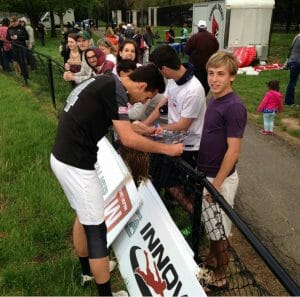
“There’s a picture of Lloyd [Blake] and I next to Zach Norrbom in 2014, with Lloyd signing a picture for Zach,” said Johnson. “And then a few years later Zach was on our team. That’s not something you get from the club season.
Going back and revisiting whether the centralization of the MLU or franchise model of the AUDL works better is, and perhaps always was, an academic debate. The reality is that the MLU was reliant on too small a set of investors that didn’t have deep enough pockets to begin with. And it was an insular organization in which one hand wasn’t always talking to the other. The fact that staff had little to no idea that the league was about to fold, that they had just moved into new offices, shows that this league had issues bubbling beneath the surface, unknown even to those closest to it.
“We used to joke around and say ‘Make sure you have that for the 30-for-30 in 20 years,” said Dewhurst. “I didn’t think we’d be discussing the aftermath of the MLU so soon after those conversations. But with everything you can look back and nitpick. I don’t have any ill will. It was fun.”
It’s hard to know what people will think when they look back on the MLU in 10 or 20 years. Much of it will probably depend on the success of its rival league, the AUDL. When the MLU started, the AUDL was nowhere near what it is today. The quality of play, attendance, and professionalism have all increased tenfold since that time. If the AUDL is successful, we might remember the MLU as the league that pushed it to greatness. If not, the MLU will end up as a fascinating relic of a time when people thought that ultimate could be monetized.
“We pushed the branding of ultimate in a ton of ways,” said Snader. “When I started people thought frisbee was a joke and now people think frisbee is awesome. I know the MLU had a part in that.”
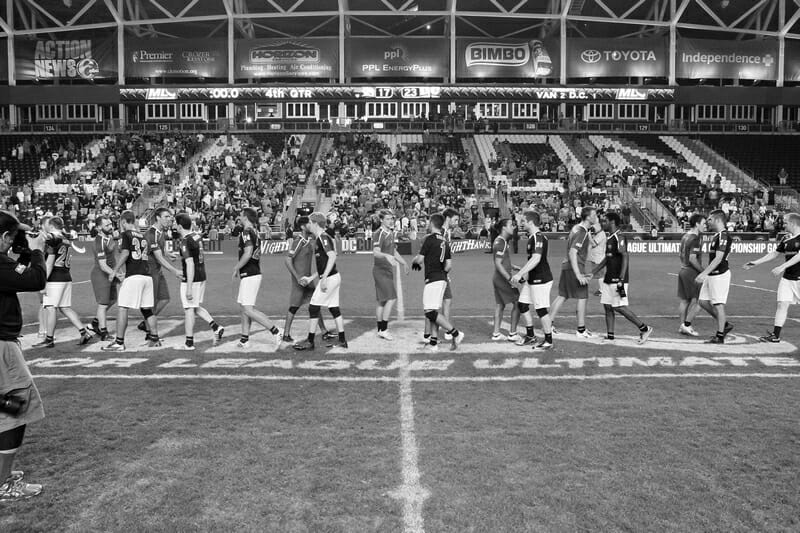
Nathan Jesson
More Features
How To Do Wildwood
A 6-chapter opus on winning Wildwood, from avoiding traffic to rocking out at the Bolero.
How To Play In The Wind
From two of the most successful strategists in the game, a comprehensive, in-depth education on how to prepare for and adapt to windy conditions better than your opponent.
Elite Player’s Perspective: The Best Pulling Games I’ve Ever Seen
Pulling matters. A statistical breakdown of two of the best pulling games of the 2016 club season.
Where Does The AUDL Go From Here?
When the American Ultimate Disc League launched in 2012, few expected it would make it this far.
